Are Sea Turtles Vegetarian?
The marine environment hosts numerous sea creatures, and sea turtles are one of the most enigmatic ones. These animals make researchers baffled when thinking about their habitats, behavior, and especially diets. Some believe they are carnivores, and others think they are vegetarians.
So, are sea turtles vegetarian? In general, sea turtles are not vegetarian. They are mostly omnivores (eat plants and animals) or carnivores (meat eaters). However, they are known to feed on various marine plants, algae, seagrasses, and invertebrates such as crabs, shrimp, and mollusks. Some sea turtles also eat fish and other small animals.
But the specific types of food that sea turtles eat can vary depending on the species and their habitat. Hence, if you want to know which sea turtle species are vegetarian and what other sea turtles consume to thrive, you may continue reading this content. Let’s get to those.
Read more about turtles blog:
Which Sea Turtles Are Vegetarian?
In essence, adult green sea turtles are vegetarian; they are herbivorous, devouring seagrass, seaweed, algae, coral, and pieces of mangrove trees. But at a particular stage of their life, these reptiles remain carnivores.
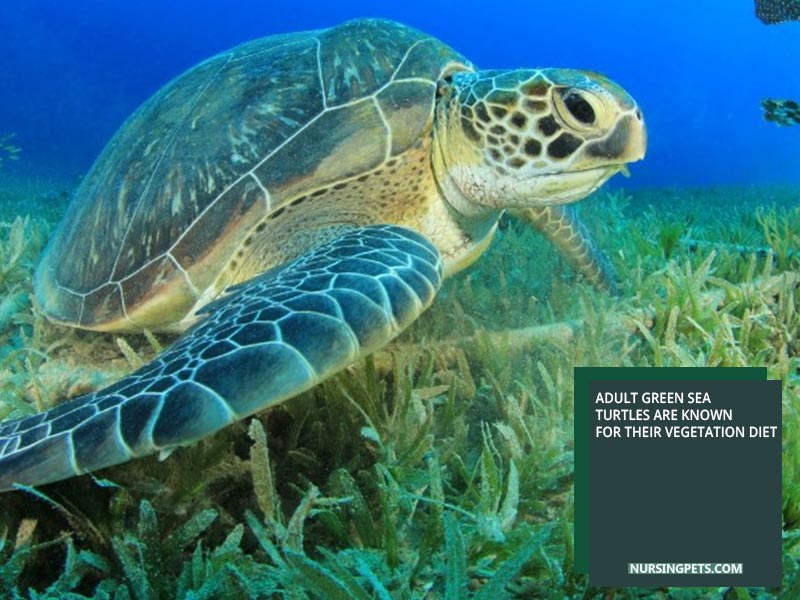
Well, when they are young, aged between 3 and 5 years, the green sea turtles’ diet includes animal-based foods, such as crab, insects, snails, jellyfish, crustaceans, worms, zooplankton, and more.
Consequently, as green sea turtles become juvenile, they consume the meat of jellyfish, crabs, and sponges and feed on a large amount of seagrass and other plant-based matter. After becoming full-grown adults, these reptiles remain vegetarians.
“We have covered an in-depth article on sea turtles; if interested, you can read our full article here.”
Feeding Habits of Different Types of Sea Turtles:
As you know, sea turtles have seven species, and below we have shared all the species’ diets except for the green sea turtle, as you already know about this turtle’s feeding habits. So, without any further ado, let’s see what do sea turtles eat.
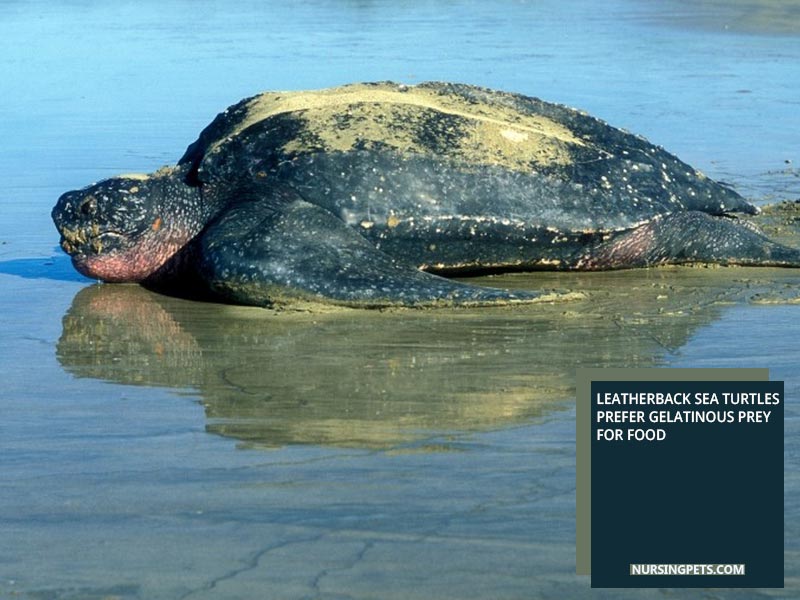
01. Leatherback
Leatherback turtles are often known as gelatinivores, which means these reptiles feed on gelatinous prey. Their diet primarily consists of jellyfish, although they also consume other soft-bodied invertebrates like tunicates, cephalopods, and sea squirts.
However, they are adapted to feed on these types of prey due to the presence of backward-pointing spines on their throat and esophagus, which help prevent the prey from escaping once it has been swallowed.
Additionally, leatherback turtles are also known to consume small fish and crustaceans occasionally. Interestingly, they can locate their prey using their keen sense of smell and their ability to detect bioelectric fields emitted by their prey.
02. Olive Ridley
Olive ridley sea turtles are omnivores and eat varied animals and plants. They feed on a variety of prey items, including algae, sponges, tunicates, anemones, barnacles, crabs, snails, and mollusks. They have also been known to eat jellyfish and other types of plankton.

As they grow larger, Olive Ridley sea turtles may also eat larger prey, such as fish and squid. That’s why Olives are known as opportunistic feeders.
Interestingly, when foraging for food, Olive Ridleys tend to feed at the bottom of the ocean, where they can find a variety of prey. They will also take advantage of the food that is floating in the water column.
03. Hawksbill
Hawksbill sea turtles are referred to as spongivores due to their specific diet, consisting of almost all sponges. These reptiles feature sharp, narrow beaks, allowing them to reach inside crevices on the reef. This way, they effortlessly catch and gobble sponges.
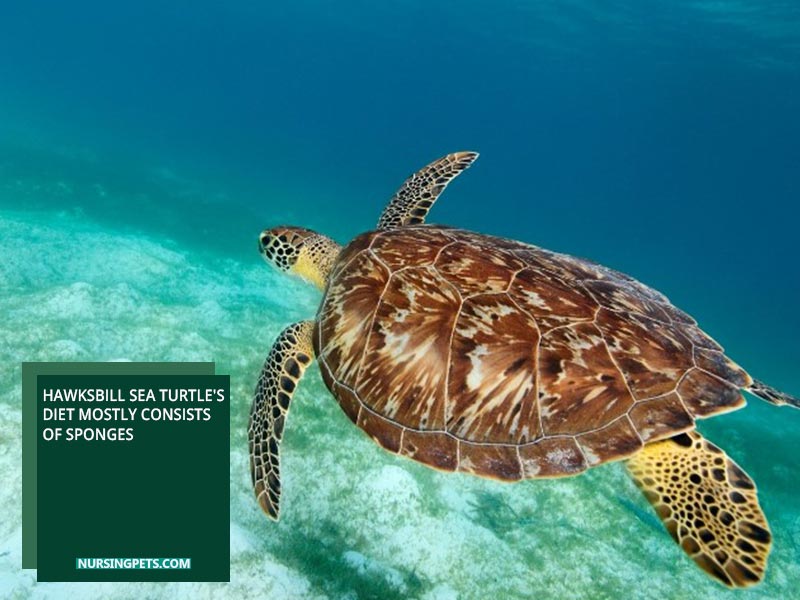
However, Hawksbill also eats other invertebrates, such as mollusks, crustaceans, and coral polyps. They may also occasionally consume algae and small fish.
The hawksbill sea turtle’s diet is also heavily influenced by its environment. For instance, in the Caribbean, the hawksbill turtle primarily eats sponges and jellyfish, while in the Red Sea, it feeds predominantly on algae and sea grasses. In the Pacific, the hawksbill turtle eats a variety of sea creatures.
04. Kemp’s Ridley
Kemp’s ridley sea turtles are carnivores and primarily eat crabs, jellies, fish, shrimp, and mollusks. Mainly, they feed on crabs, though. However, Ridley often scavenges for food in the form of dead fish, crabs, mollusks, and small marine creatures; and occasionally feeds on algae and seaweed.
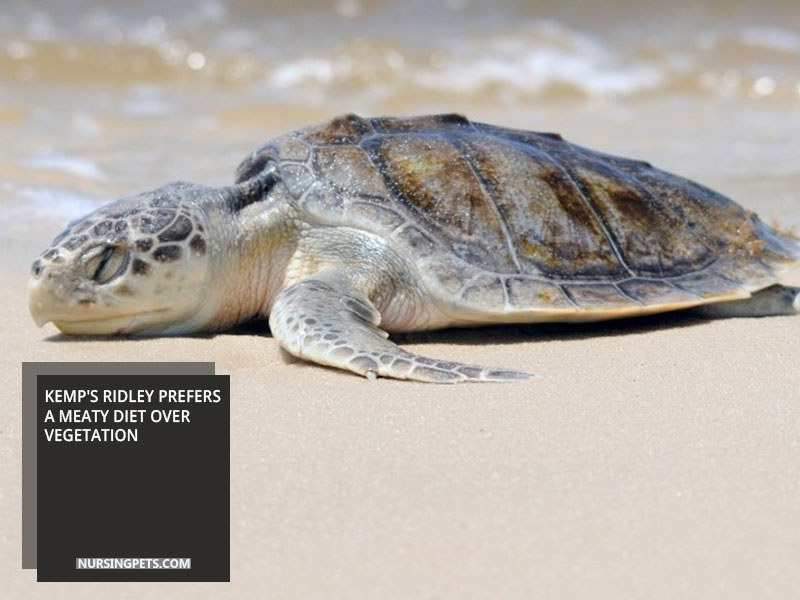
Moreover, Kemp’s Ridley also feeds on the eggs of other sea turtles, such as their own and other turtles. They also eat the eggs of other reptiles, such as sea snakes and small birds. Foraging is an important part of their diet; they can dive up to 50 meters to find food.
05. Loggerhead
Like the kemp’s ridley turtles, loggerheads are also carnivores, consuming crabs, conchs, and whelks. In their juvenile and young adult stages, they primarily feed on animals such as mollusks, crustaceans, and fish.
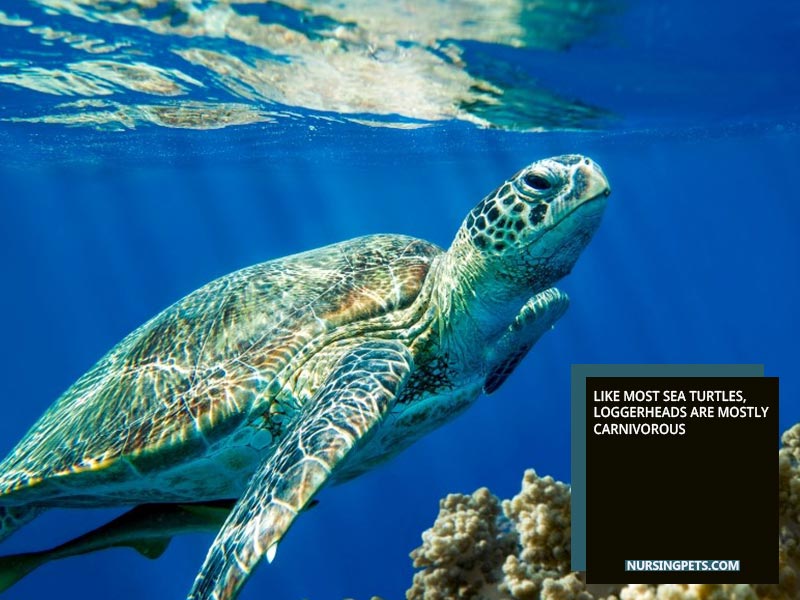
As they mature and reach adulthood, their diet becomes more varied, and they may also consume sea grasses and algae. Loggerheads can eat large amounts of food in a single day. They can consume up to 6% of their body weight daily, equivalent to an 80-pound human eating 15 pounds of food.
Loggerhead sea turtles are also known to feed on cephalopods, such as octopuses and squid. These sea turtles will also take advantage of carrion or dead animals when they come across them.
06. Flatback
Flatback sea turtles, also known as Natator depressus, are a large species of sea turtles that inhabit the waters of Australia and parts of Southeast Asia. And for diet, Flatback sea turtles are omnivores and devour sea cucumbers, soft corals, shrimp, crabs, mollusks, fish, jellies, and more.
They also feed on sea grasses, seaweed, and algae. And flatback is particularly fond of the green seaweed known as Ulva.
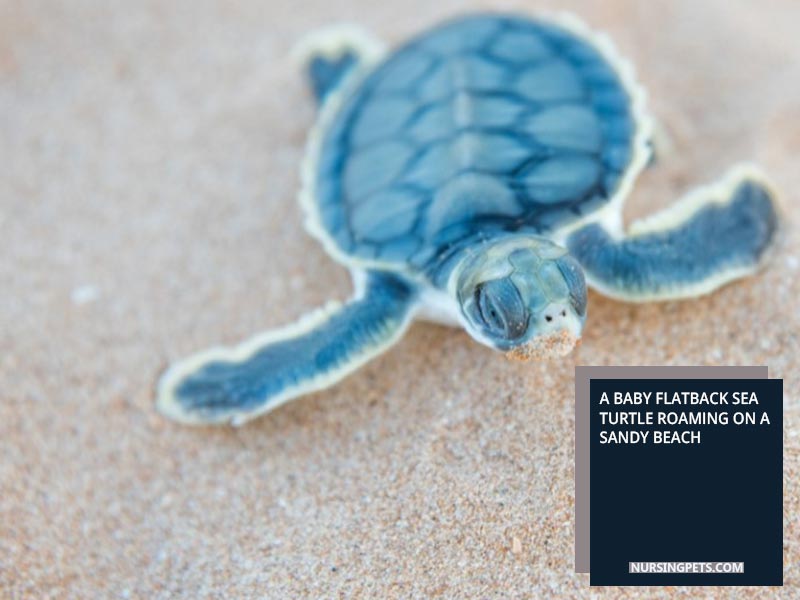
So, as you can see, sea turtles’ diets differ from species to species, and what they eat significantly varies depending on age.
Now, let’s discuss “how often do they need to eat?” and “how much do they eat?”.
Baby sea turtles need to consume food every day, and once they become one year old, they spend a day without eating. However, adults can fast for two to three days. But to stay healthy, they must eat around 73% of their body weight daily. Otherwise, thriving will be incredibly challenging for these marine creatures.
Reasons Why Sea Turtles Are Not Vegetarian
Most Sea turtles are carnivores and omnivores and feed on jellies, fish, crabs, and other marine invertebrates. On the contrary, a small number of sea turtles consume seagrass and seaweed.
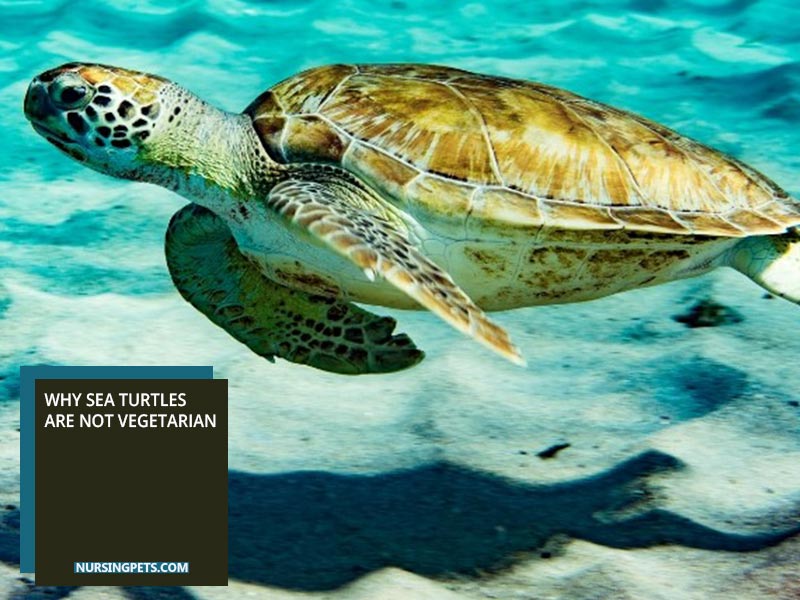
So, considering this fact, we can’t put all sea turtles in the vegetarian group. However, you can keep the adult green sea turtle in the vegetarian group, as these reptiles eat seagrass and seaweed exclusively.
How Does Green Sea Turtles’ Vegetarian Diet Help Maintain The Marine Ecosystem?
As you know, adult green sea turtles primarily feed on sea grasses; they perform the duty of aquatic lawnmowers; how? Well, by consuming sea grasses, green sea turtles keep seagrass beds healthy and ease other marine creatures’ life as seagrasses offer food, habitat, and shelter to many fish species.
Not only that, green sea turtles balance the marine environment by keeping the seagrass beds healthy. FYI, healthy seagrass beds stabilize the ocean bottom, helping decrease erosion from wave action and storms.
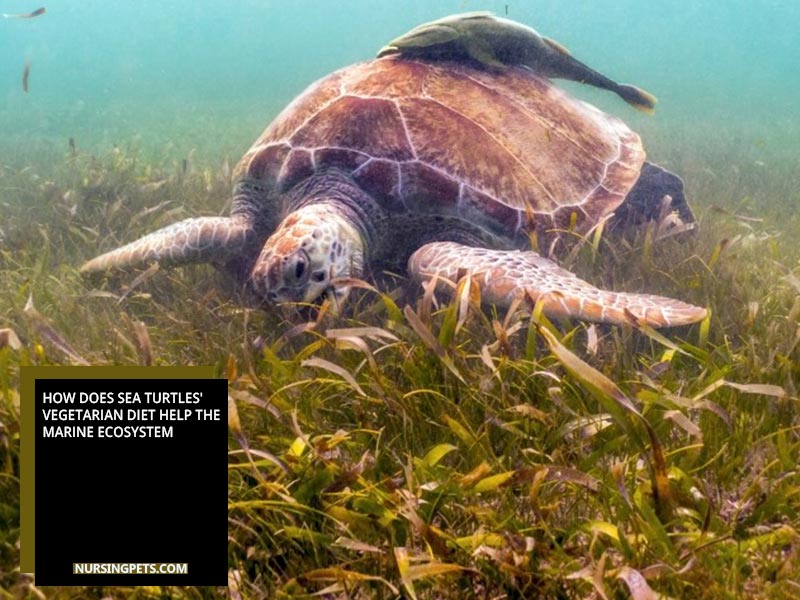
Lastly, green sea turtles help maintain the coral reefs’ health; these turtles gobble algae, and as you know, algae are the enemy of corals as they release sugar, fuelling the bacterial growth in corals and leading them to death. Hence, this is how green sea turtles help balance the marine ecosystem by being vegetarian.
Frequently Asked Questions
1. Do sea turtles eat plants?
Sea turtles primarily eat/prefer animals such as jellyfish, crustaceans, mollusks, etc. However, some species of sea turtles may also consume small amounts of seagrass or other aquatic plants as part of their diet.
And according to the National Oceanic and Atmospheric Administration (NOAA), green sea turtles are known to eat seagrass and other aquatic plants. They are herbivores and are known to feed on a variety of seagrass species, including Thalassia testudinum and Halodule wrightii.
2. Are there any vegetarian turtles?
To be blunt, no turtle species is purely vegetarian. However, some species of turtles are primarily vegetarian. For example, the Eastern Box Turtle is known to eat a diet mostly composed of plant material, including flowers, fruit, and leaves.
The Red-Eared Slider is also known to eat a diet consisting mainly of plants, including lettuce, kale, and other leafy greens. And adult green sea turtles are another species known on this diet. But you have to remember; the diet will vary depending on the turtle species, habitat, and food availability.
To Conclude
Sea turtles are one of the oldest marine creatures with diverse diets. What they eat varies from species to species, and you already know about that. They can be carnivores, omnivores, gelatinivores and indeed herbivores. That said, now you know whether sea turtles are vegetarian or not.
Next time someone asks this question, you can answer them without guessing and send this content as a reference via Facebook, Twitter & Pinterest. That’s all for this one; we will catch you with another fantastic article.
Image Source: Canva.com/photos
Information Resources:
- Seeturtles.org/sea-turtle-diet
- Seaworld.org/animals/all-about/sea-turtles/diet/
- Nationalgeographic.com/science/article/how-leatherback-turtles-grow-huge-on-a-diet-of-jelly
- Seeturtles.org/why-are-sea-turtles-important
- News.ucsb.edu/2006/012146/coral-death-results-bacteria-fed-algae

